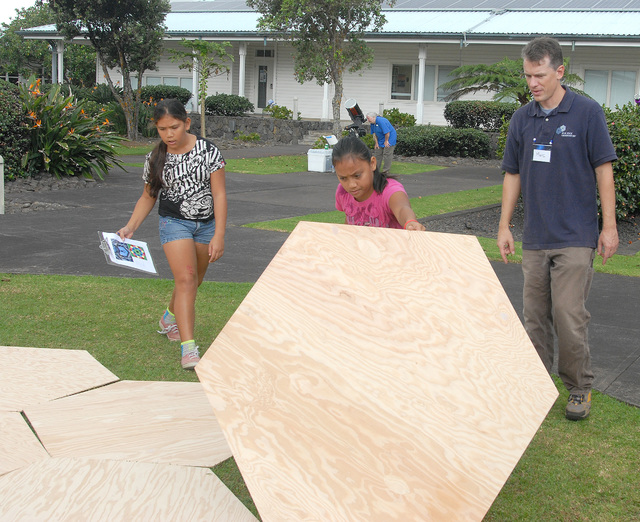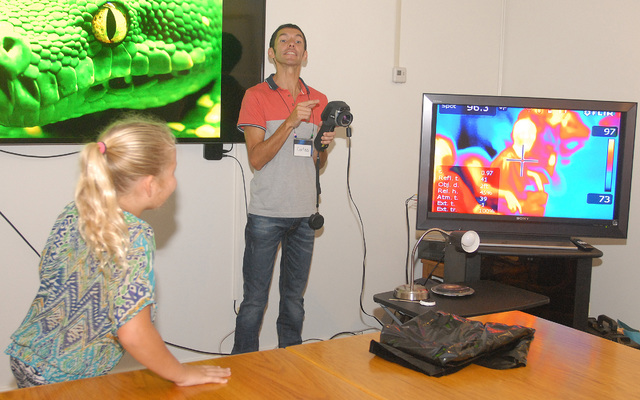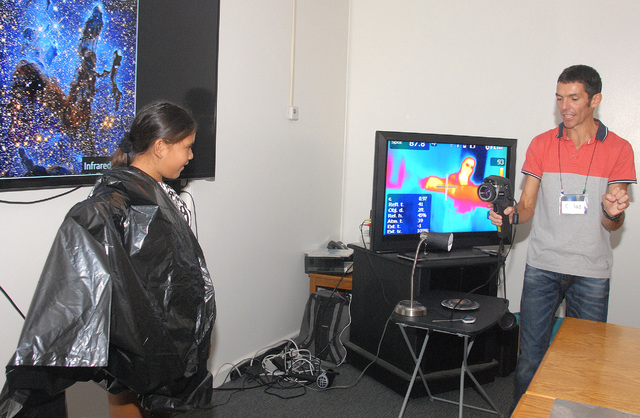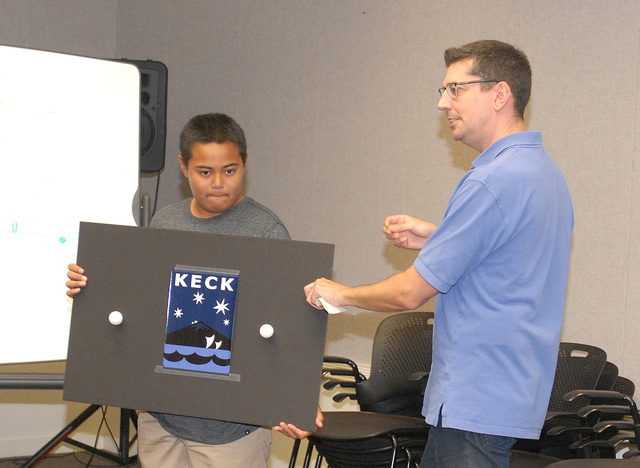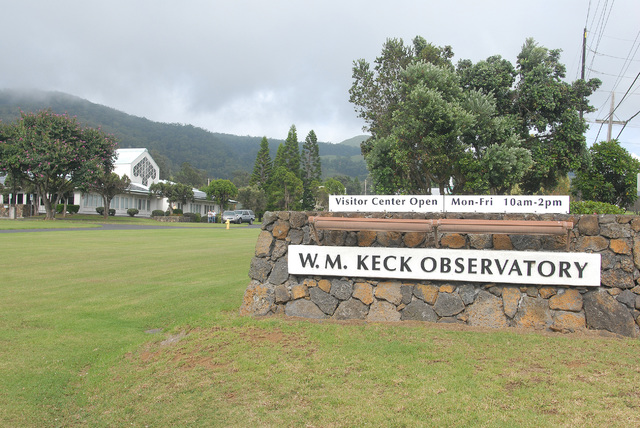WAIMEA — Naomi Brooke, a fifth-grader at Kohala Elementary School, lifts her hand off the table and glances at the video screen showing a perfect thermal image of her handprint, as seen through an infrared camera.
“We’re going to see through things,” said astronomer Carlos Alverez, as he pointed the camera at fifth-grader Megan Hoopai’s arm, clearly visible inside a black plastic bag the girl put on for the demonstration.
“I think that was good — I could see my handprint on the TV but not on the table,” Brooke said, resuming her seat amid her classmates.
Brooke and Megan were two among dozens of elementary and middle school students who visited the W.M. Keck Observatory on Tuesday to help celebrate its 25th anniversary of first light. The excitement of the schoolchildren was contagious, as the budding astronomers learned about infrared cameras, telescope tracking and putting a giant mosaic of hexagon panels together to simulate a mirror.
The hexagon panel is what the celebration was all about, said Rich Matsuda, operations manager at the observatory. Keck Observatory was the first ever to use a jigsaw puzzle of mirrored tiles to focus light in a telescope, paving the way for the much larger telescopes of today.
“This anniversary is very special,” Matsuda said. “Twenty-five years ago today, we had the very first starlight on our telescopes.”
That starlight came from a spiral galaxy 65 million light-years away.
Before the Keck Observatory was built, the most powerful telescope in the world was the 200-inch Hale Telescope at Palomar Observatory near San Diego. The first Keck 10-meter optical/infrared telescope worked so well, the observatory immediately was awarded another grant to build its twin, Matsuda said.
Today, all the next revolutionary telescopes, on the ground and in space, are being designed using the architecture developed and perfected by Keck Observatory.
Before this breakthrough, the power of telescopes was limited by the size of the mirror, and mirrors featuring one large piece of material were just too heavy after a certain size. The new “segmented mirror” telescope laid the groundwork for the massive telescopes being constructed today, such as the Giant Magellan Telescope in Chile and the Thirty Meter Telescope on Mauna Kea.
Not only did those earlier scientists have to learn to string together larger mirrors, the computer technology had to be in place to allow microscopic connections and adjustments when fitting the mirrors together.
“Back then, you needed a big honking computer to do it,” Matsuda said. “Now, you almost do it with your iPhone.”
The margin for error is slim, Matsuda said. For example, if the Keck mirrors were expanded to the size of the Big Island, the difference in their smoothness would be less than the thickness of a credit card, he said.
“The segments all have to fit really near perfect,” Matsuda said.
Mauna Kea was identified by the project team as the best site on Earth for astronomy. It since has been measured as having the best seeing conditions on Earth. The height of the mountain, placing it above much of the atmosphere, lack of light pollution leading to clear, dark skies and dry summit air with minimal turbulence made it the only location that would allow the Keck Observatory to reach its tremendous scientific potential, according to a University of Hawaii news release sent Tuesday.
“Thanks to the pristine conditions on Maunakea and the incredible work and ongoing efforts of hundreds of Hawaii residents, Keck Observatory has become the pride of Hawaii, contributing more to humankind’s understanding of the Universe than any other research facility on Earth,” Hilton Lewis, a member of the original project team and director of the W.M. Keck Observatory, said in a statement.
Perhaps the biggest discovery is how much remains unknown.
“There are as many unanswered questions as ever, 25 years later. If anything, the mysteries are deeper. Each layer we pull back reveals more complexity,” Lewis said.
Keck Observatory is a private nonprofit organization and a scientific partnership of the California Institute of Technology, the University of California and NASA.
Email Nancy Cook Lauer at ncook-lauer@westhawaiitoday.com.






